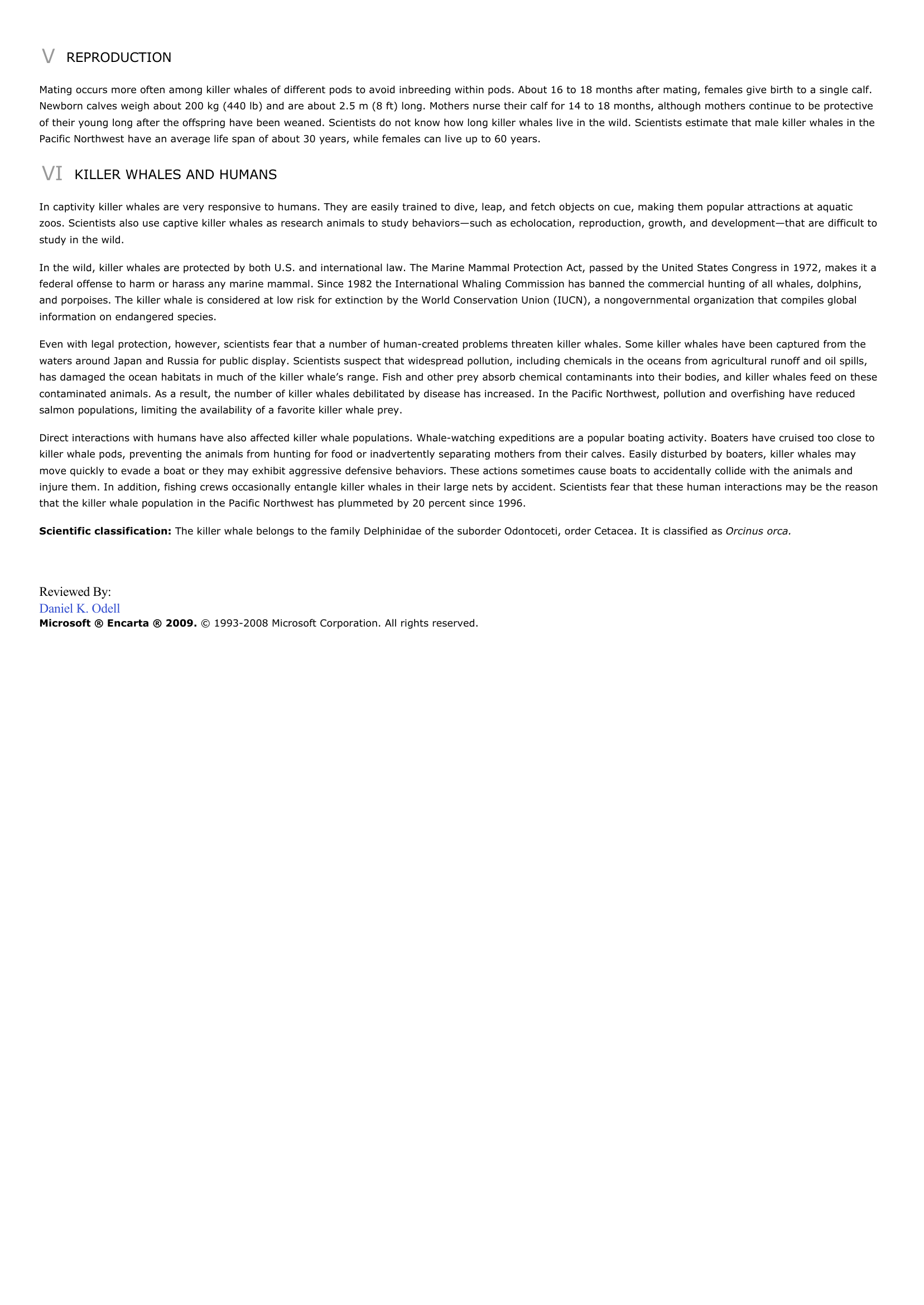Killer Whale - biology.
Publié le 11/05/2013

Extrait du document
«
V REPRODUCTION
Mating occurs more often among killer whales of different pods to avoid inbreeding within pods.
About 16 to 18 months after mating, females give birth to a single calf.Newborn calves weigh about 200 kg (440 lb) and are about 2.5 m (8 ft) long.
Mothers nurse their calf for 14 to 18 months, although mothers continue to be protectiveof their young long after the offspring have been weaned.
Scientists do not know how long killer whales live in the wild.
Scientists estimate that male killer whales in thePacific Northwest have an average life span of about 30 years, while females can live up to 60 years.
VI KILLER WHALES AND HUMANS
In captivity killer whales are very responsive to humans.
They are easily trained to dive, leap, and fetch objects on cue, making them popular attractions at aquaticzoos.
Scientists also use captive killer whales as research animals to study behaviors—such as echolocation, reproduction, growth, and development—that are difficult tostudy in the wild.
In the wild, killer whales are protected by both U.S.
and international law.
The Marine Mammal Protection Act, passed by the United States Congress in 1972, makes it afederal offense to harm or harass any marine mammal.
Since 1982 the International Whaling Commission has banned the commercial hunting of all whales, dolphins,and porpoises.
The killer whale is considered at low risk for extinction by the World Conservation Union (IUCN), a nongovernmental organization that compiles globalinformation on endangered species.
Even with legal protection, however, scientists fear that a number of human-created problems threaten killer whales.
Some killer whales have been captured from thewaters around Japan and Russia for public display.
Scientists suspect that widespread pollution, including chemicals in the oceans from agricultural runoff and oil spills,has damaged the ocean habitats in much of the killer whale’s range.
Fish and other prey absorb chemical contaminants into their bodies, and killer whales feed on thesecontaminated animals.
As a result, the number of killer whales debilitated by disease has increased.
In the Pacific Northwest, pollution and overfishing have reducedsalmon populations, limiting the availability of a favorite killer whale prey.
Direct interactions with humans have also affected killer whale populations.
Whale-watching expeditions are a popular boating activity.
Boaters have cruised too close tokiller whale pods, preventing the animals from hunting for food or inadvertently separating mothers from their calves.
Easily disturbed by boaters, killer whales maymove quickly to evade a boat or they may exhibit aggressive defensive behaviors.
These actions sometimes cause boats to accidentally collide with the animals andinjure them.
In addition, fishing crews occasionally entangle killer whales in their large nets by accident.
Scientists fear that these human interactions may be the reasonthat the killer whale population in the Pacific Northwest has plummeted by 20 percent since 1996.
Scientific classification: The killer whale belongs to the family Delphinidae of the suborder Odontoceti, order Cetacea.
It is classified as Orcinus orca.
Reviewed By:Daniel K.
OdellMicrosoft ® Encarta ® 2009. © 1993-2008 Microsoft Corporation.
All rights reserved..
»
↓↓↓ APERÇU DU DOCUMENT ↓↓↓
Liens utiles
- Whale Shark - biology.
- Blue Whale - biology.
- Whale - biology.
- Frankenstein [James Whale] - analyse du film.
- Ceto (Whale) Greek An ancient Greek sea goddess.









